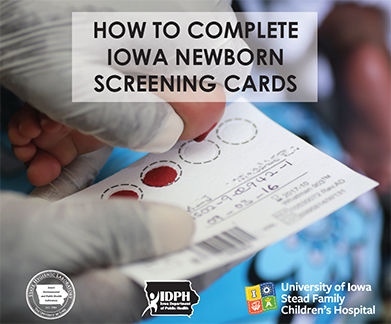New manual guides newborn screening process
May 30, 2017 -- Every year, about 40,000 babies are born in Iowa. For each of these, nurses and midwives must complete information on a collection form used to begin the process of newborn screening. Newborn screening can save babies from devastating, sometimes life-threatening health conditions.Completion of a form with more than 40 fields in which to enter information may seem like a straightforward process. But issues may occur in completing the form or collecting the blood spots that may result in delays in detection and/or treatment of conditions that can cause irreversible harm to a baby in a matter of hours after birth.
For example, missing information about a family’s address, a poorly collected sample or not identifying the health care provider who will be caring for the newborn once the baby is home can delay notification of a condition detected in screening. Many medical issues, including transfusions, drawing a sample for low birth-weight baby, or underlying health conditions also can complicate the process. Any of these issues – and many others – may delay treatment.
A new manual developed by the Iowa Newborn Screening Program seeks to remedy this. Ashley Comer, Hygienic Laboratory program coordinator, and Emily Phillips, Medical Genetics Follow-up staff nurse, led the development of “How to Complete Iowa Newborn Screening Cards” to explain in a step-by-step manner the collection process and answer many related questions.
As part of the Iowa Newborn Screen Program team, Comer and Phillips are delivering and introducing the instructional manual to staff at birthing facilities across the state, including 80 hospitals and 12 homes of midwives.
The manual is designed as a small flip chart that can easily be hung on a bulletin board or wall, and quickly accessed by those tasked with this vital step in newborn screening. It augments other training by professional organizations, other birthing facility staff or midwives.
"Ashley Comer and Emily Phillips, Iowa Newborn Screening Program staff, have created a valuable tool for health care providers to guide them through the newborn screening specimen collection process,” said Kim Piper, executive office of the Center for Congenital and Inherited Disorders and state genetics coordinator.
“This manual serves as a ‘just-in-time’ resource at the fingertips of the health care provider for quick reference to enhance the quality of the newborn screening specimen,” Piper said. “Iowa's babies will benefit from the reassurance that a quality specimen is available for screening.”
An electronic version of the manual is available on the State Hygienic Lab and IDPH websites.
Questions about hard copies or other inquires may be sent to HLA-NBS-DataEntry@uiowa.edu.




